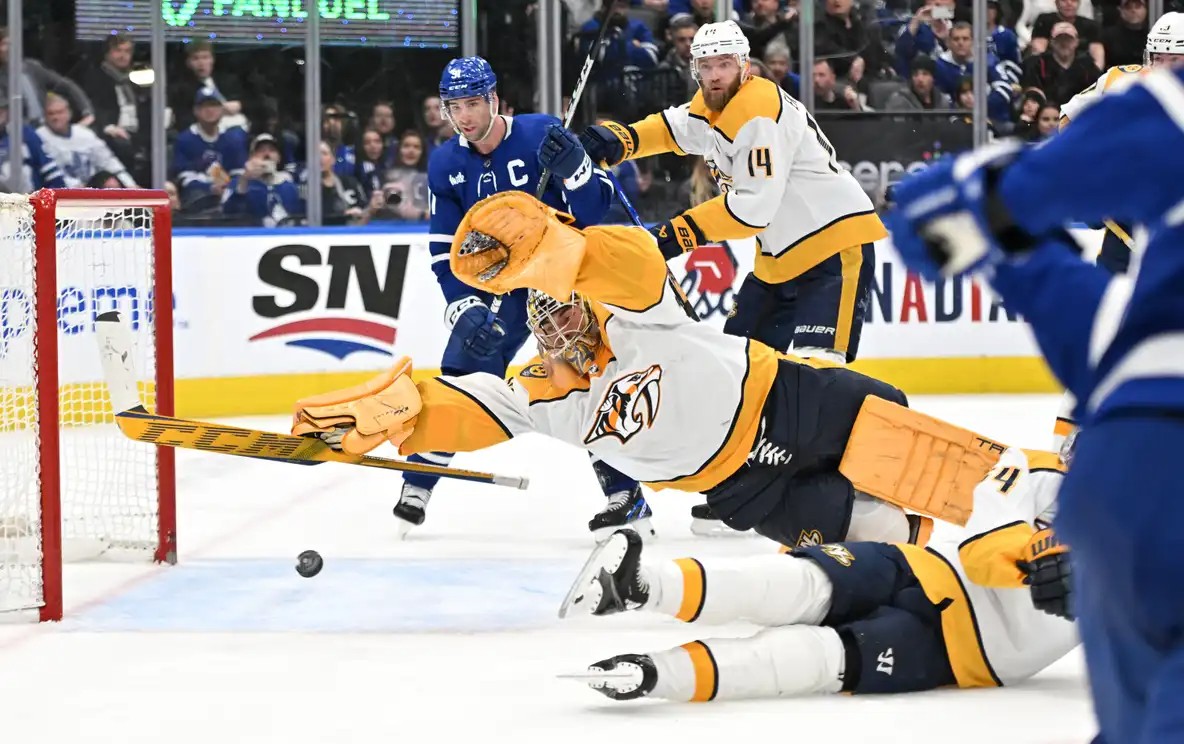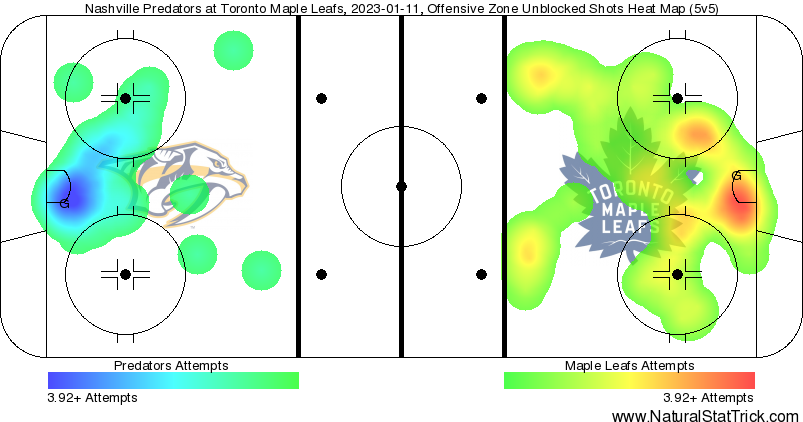With Auston Matthews out of the lineup, the Maple Leafs struggled to figure out Juuse Saros until finally breaking through on the power play late in the third period to secure a 2-1 victory over the Nashville Predators at Scotiabank Arena on Wednesday night.
Bobby McMann made his NHL debut in the absence of AM34, John Tavares stayed hot, and Matt Murray delivered another excellent performance in net for the Leafs, who won their third consecutive and moved to 8-2-0 without Matthews since the start of the 2021-22 season.
Your game in 10:
1. With TJ Brodie landing on the IR recently, the Leafs are continuing to experiment with the pairing of Morgan Rielly and Justin Holl. Rielly is generally always going to be Rielly, but Holl is moving away from a very different type of partner in Mark Giordano.
Right from the jump, it didn’t appear that Holl accounted for those differences. Rielly broke out of the Toronto zone to lead the rush, entered the offensive zone, and went deep into the corner. The puck rimmed around to the opposite point, and rather than backing off with his partner in deep, Holl pinched hard. It worked momentarily, but eventually, the puck was flipped out over his head, sending the Predators on an odd-man rush situation and creating their first A+ chance of the night on Matt Murray:
big saves for Murray early pic.twitter.com/sm2enCCb06
— Omar (@TicTacTOmar) January 12, 2023
Tanner Jeannot was shut down on that mini-break before moments later, Murray delivered one of his best saves of the season with the ol’ Hašek roll:
MATT MURRAY!
DESPERATION SAVE! pic.twitter.com/3K2gJsWVpE
— Omar (@TicTacTOmar) January 12, 2023
Those were huge early saves for Murray in terms of getting the goalie in a rhythm, but they’re chances Sheldon Keefe would’ve detested giving up. I don’t know how long Rielly and Holl will play together — as such, I don’t want to spend too much time on it — but Holl has to have more awareness of who he’s playing with and where his partner is on the ice.
2. The Leafs went on the PK in the first period when Dryden Hunt delivered a crosscheck in the offensive zone, another thing that likely will annoy Keefe. For Hunt, it was the only time I noted his presence in the game, which is generally not a great sign. It was a pretty quiet night for the fourth line, and the one thing they can’t be doing in their time on the ice is either give up goals or take dumb penalties.
In six games now with the Leafs, I have not seen a ton from Hunt that makes me think he’s going to stick in the Toronto lineup permanently. Some attention needs to be paid to figuring out that fourth line to get it more productive and effective come playoff time.
3. On the penalty kill caused by the Hunt penalty, the Leafs did a very poor job of preventing high-danger chances. This was a theme that persisted throughout much of the game: The Leafs limited the quantity of chances but not so much the quality of said chances.
First, Matt Murray shut down a good look from Filip Forsberg in the slot before he stopped Cody Glass’ tip off of a beautiful pass from Ryan Johansen. He then denied Glass again on a deflection from the high slot, leading to a scrum in front.
Murray was very composed and strong positionally in his crease, rarely swimming around or losing his anchor. He tracked the puck well and was ready when it arrived. The Leafs’ team defense was wobbly at times, but their goalie consistently bailed them out in the key moments.
4. One scoring chance for Toronto stood out to me besides their goal: The D-to-D pass by Rasmus Sandin to Timothy Liljegren in the offensive zone. Sandin had the puck on the half-wall and Liljegren made a back-door cut across the zone, catching the Nashville player responsible for him by surprise. After Sandin got him the puck, Liljegren just missed the lane to slide it through the pads of Juuse Saros:
Sandin from the wall finds Liljegren in front of the net pic.twitter.com/7wUw6I8Ejh
— Omar (@TicTacTOmar) January 12, 2023
There’s been a lot of talk around the league about why scoring is up over the last few years and why it’s stayed up this season. There are many factors at play, but the fact that plays like this are now in the toolbox for most good NHL teams is one reason why.
It’s pretty stark if we go back in time and watch NHL games from the pre-lockout era or even as late as 10 or so years ago. Defensemen simply didn’t make plays like that.
Think about the Pat Quinn-era Leafs, for example. Tomas Kaberle was a slick puck-mover, but the fan favorite of those teams, Bryan McCabe, was a blast-it-from-the-point defenseman of the kind that was so common in that era. If we pull up the top point-getters as defensemen from the mid-2000s, so many were McCabe types (sometimes McCabe himself was on the list).
Now, there is a clear premium placed on defensemen who are more mobile and aggressive in the OZ. The Leafs under Shanahan have played their role in that change. Two defensemen making plays together in the offensive zone like the one above encapsulates a defining characteristic of the modern hockey era.
5. The Leafs broke through in the first period by playing ultra-aggressively in the neutral zone. The Predators were dead-set on making (predictable) stretch passes through the middle of the ice, and the Leafs started reading them like a book. There was a sequence of several interceptions leading up to the Leafs’ goal, and all of them looked like a cornerback in football reading the QB’s eyes, making a break on the ball early, and picking it off.
The one that triggered the goal was an intercept in the NZ by Timothy Liljegren, who flipped the puck ahead to William Nylander to create a mini 2v1 with John Tavares. Nylander deked in tight and slipped a pass across before Tavares got just enough on it to beat Saros:
JOHN TAVARES 🚨
THE CAPTAIN HAS 20 pic.twitter.com/oOOEpjCpLO
— Omar (@TicTacTOmar) January 12, 2023
Tavares now has a goal in four straight games and has eight points in those four games. He also now has 20 goals, with a legitimate shot to score 40 this season for the Leafs. His 20 goals give him his 13th 20-goal season, tying him with a whole host of names including Bobby Hull, Jari Kurri, Guy Lafleur, Sergei Fedorov, Brian Trottier, and Jean Beliveau.
Tavares has scored 20+ in 13 of 14 career seasons, and the only one where he didn’t hit the mark was the 2020-21 COVID season (he scored 19 in the league-maximum 56 games). Even when he’s fallen off the upper echelon of the goal-scoring chart, few players have been as consistently good over the past two decades at dependably chipping in 20+ as the Leafs’ captain.
6. It didn’t take long into the second period for the Predators to get even, and it was the Morgan Rielly and Justin Holl pairing in the middle of it again.
Rielly turned the puck over as the forwards exited the defensive zone, leading to a 2v1 down low with only Holl back. It was not a good situation for Holl to be in, but he did very little to take the pass away. Nashville’s Juuso Parssinen made a great pass across to Forsberg, who showed off his silky mitts in dangling Murray and scoring an easy goal.
There was not a whole lot Murray could do there as he slid across. His best chance was to get the stick in the way to break up the deke, but this one is on Rielly and Holl. It was not their best night.
7. The Leafs went to two power plays in the second after one in the first, and the cumulative sum of those opportunities was extremely disappointing: one scoring chance, zero high-danger chances, and 0.1 expected goal for in six minutes of time (data via Natural Stat Trick).
On the first two opportunities, the Leafs really struggled to enter the zone with possession and set up. They didn’t create anything resembling a chance on their first-period PP, and while the second period went a little better, they still had their issues with the entries. Once they were set up, Nashville put plenty of pressure on the puck and denied passes to the bumper position.
The Leafs didn’t handle it well, and it felt like they were stuck in the mud spinning their tires. It was the most disappointing part of the game for the Leafs — until it redeemed itself.
8. The redemption came late in the third period after the two teams traded some looks. Nashville created an A+ chance for Tommy Novak, but Murray made a huge save; Mark Giordano blocked a great look for the Predators created off a Conor Timmins DZTO, and Juuse Saros made a few saves on abbreviated odd-man rushes.
As the clock ticked down under five minutes, Nashville’s Mark Jankowski went into the corner on the forecheck and got his stick up high, whacking Morgan Rielly in the nose and drawing blood. It took the referees a few seconds to catch it, but they got the call right and handed the Leafs a four-minute PP that would, if it went to completion, soak up almost all of the remaining time in regulation.
The PP was largely uneventful for the first three minutes, but the Leafs did eventually set up and the big-budget stars got it done.
John Tavares held the puck behind the net and made a quick pass to the right-wing boards for William Nylander, who delivered a dagger across the seam for Mitch Marner. Saros was aggressive in sliding across the crease all night, and after biting on the shot threat from Nylander, even a goalie with his elite skating ability couldn’t get across in time on Marner. #16 made no mistake:
Nylander sells the hell out of this shot pic.twitter.com/GZQipxJ5sl
— Omar (@TicTacTOmar) January 12, 2023
A great display of passing put the Leafs ahead with 1:15 left, and a second goal created by Nylander on a night when the biggest of the big four was absent.
The Predators generated one point shot scramble with the goalie pulled, but Murray stood tall and closed out another win for the Maple Leafs.
9. This was one of Matt Murray‘s best games of the season in your author’s opinion, saving 32 of 33 shots he faced for a crisp .970 SV%. After a very poor showing against Seattle last week, he’s rebounded convincingly with two excellent showings against Philadelphia and Nashville.
The Leafs were a little sloppy defensively and in handling the puck, and Murray was forced to make a number of point-blank, high-danger saves.
well that could've been bad
good save from Murray pic.twitter.com/jGCNxpJOgu
— Omar (@TicTacTOmar) January 12, 2023
Natural Stat Trick put Murray down for 1.5 goals saved above expected — a great performance and probably his best game since the robbery in Dallas in December.
Through 17 games, Murray now has a .919 SV% with an 11-4-2 record in those games. As we sit at essentially the halfway point of the season, it’s hard to have many gripes with Murray’s year to date.
10. Let’s close it out with Bobby McMann, Toronto’s AHL call-up from the Marlies who made his NHL debut with Matthews out. McMann logged 11:01 TOI tonight — not too shabby when we consider this was a tight game from start to finish.
McMann’s underlying numbers were not particularly great tonight, but I thought the eye test was much kinder to him. The 6’2 winger flashed his speed, motor, and some decent hockey sense. He had a great hustle play off the rush, diving to knock the puck ahead to Alex Kerfoot for a chance in tight that Saros saved:
what a rush from Bobby McMann pic.twitter.com/tMtLScsTcX
— Omar (@TicTacTOmar) January 12, 2023
McMann also showed off solid instincts moving to the back post on an in-zone chance, where he was open for a tap-in goal if Rasmus Sandin had found him (Sandin instead opted to shoot). It was not a flashy debut — and who knows how long he’ll be up in the NHL — but I thought McMann was solid.
The other storyline of note entering the game was William Nylander shifting to center ice in Matthews’ absence, but it was something we saw Keefe start to move away from as the Leafs continued to search for additional offense in the game, shifting Alex Kerfoot there instead. At times of an injury to one of Matthews or Tavares, it’s often been Kerfoot in the middle and Nylander back to the wing when push comes to shove for Keefe.
Keefe’s point after the game about Nylander’s want to take off as the first forward out of the zone is noteworthy; it was apparent at different points, including before the 1-1 goal. The goal was not on Nylander so much as Rielly’s giveaway, but in the sequence beforehand, you could clearly see the desire to “go” from Nylander as opposed to naturally assuming the center’s responsibility of patiently hanging deeper in the defensive zone to support the puck.
Time and again, Keefe lands back on the preference of keeping Nylander on the wing, where he’s at his most dangerous in terms of stretching the ice and providing a lethal transition threat.

































